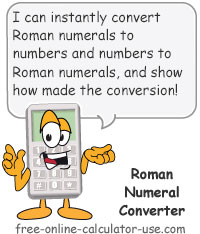IMPORTANT: Numeric entry fields must not contain dollar signs, percent signs, commas, spaces, etc. (only digits 0-9 and decimal points are allowed).
Click the Terms tab above for a more detailed description of each entry.
Step #1:
Enter either an Arabic (whole) number less than 4000, or a Roman Numeral up to MMMCMXCIX (3999). Tapping one of the plus (+) icons will open the corresponding keypad.
Step #2:
Click the "Convert Roman or Arabic" button, which will display the result of the conversion and display a conversion chart showing how the calculator arrived at the result.
Step #3:
If you would like to create a printable Roman numerals conversion chart, enter the starting and ending Arabic numbers, and then click the "Roman Numeral Chart" button, which will open your custom chart in a new window for printing.


Follow me on any of the social media sites below and be among the first to get a sneak peek at the newest and coolest calculators that are being added or updated each month.